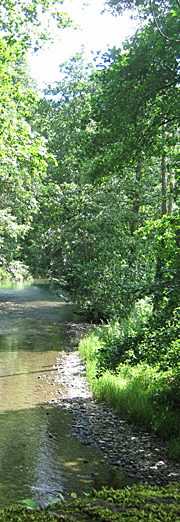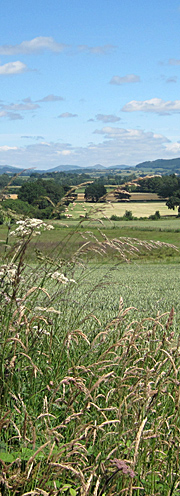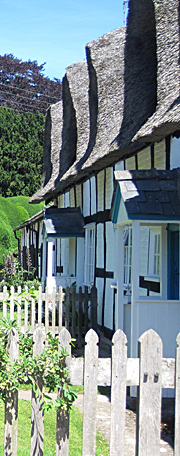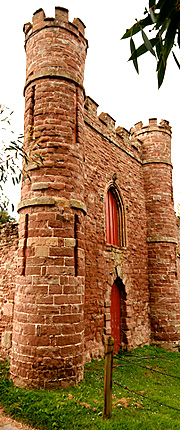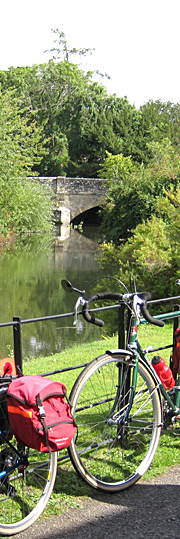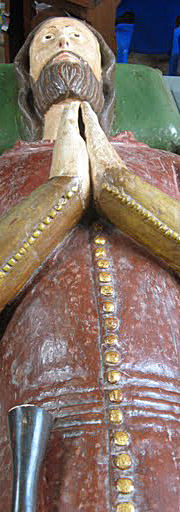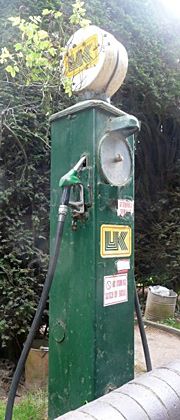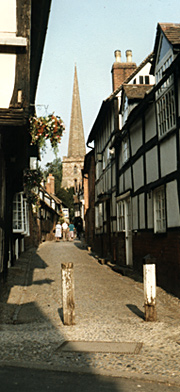Cycling in Herefordshire
Herefordshire is a fascinating landscape peppered with black & white cottages, ivy-clad castles, picturesque churches, and apple orchards. Nestling against the Welsh border and the Black Mountains, this is a half-forgotten gem - a borderland fought over by the English and Welsh for hundreds of years.
Look who we found while cycling in Herefordshire...

Black & White Villages
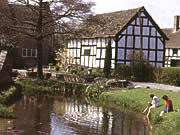 North
Herefordshire is famous for its black & white villages, such as
Eardisland and Pembridge. This is a really great area to cycle
around.
North
Herefordshire is famous for its black & white villages, such as
Eardisland and Pembridge. This is a really great area to cycle
around.
'Black & White' refers to the 16th & 17th century style of building - constructed of unseasoned oak in-filled with lath and plaster. It became fashionable in Victorian times to pick out the exposed timbers with black paint and lime wash the plaster.
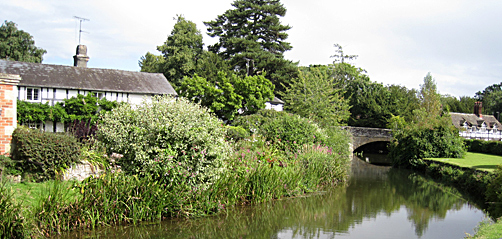
Photo: River Arrow at Eardisland
 Herefordshire
County Council produced a handy Black
& White Villages Cycle Ride map (9 or 15 miles, easy).
Don't pick up the car route by mistake, it only follows 'A' roads.
For a longer cycling route download Visit Herefordshire's Black
& White Village Trail.
Herefordshire
County Council produced a handy Black
& White Villages Cycle Ride map (9 or 15 miles, easy).
Don't pick up the car route by mistake, it only follows 'A' roads.
For a longer cycling route download Visit Herefordshire's Black
& White Village Trail.
Wibbley Wobbley Weobley
Another black & white village worth visiting is Weobley, if only for lunch at the "cyclists welcome" Jules - the owner, Jules is an old-time cyclist. And if Jules isn't open, there's the Green Bean cafe and Ye Olde Salutation Inn.
The Deerfold & Mortimer Forest
This is one of our favourite parts of Herefordshire. It is well worth cycling into these bumpy tree-covered hills in north-west corner of the county, bounded by Ludlow, Presteigne and Brampton Bryan.


Not only quite lanes but also picturesque villages - such as Wigmore (2 great pubs), Lingen, Leinwardine (2 great pubs), Amyestry (pub and tearoom), and Brampton Bryan (great tearoom at Aardvark Books) with its brilliant yew hedge...
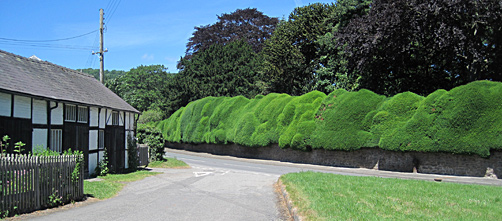
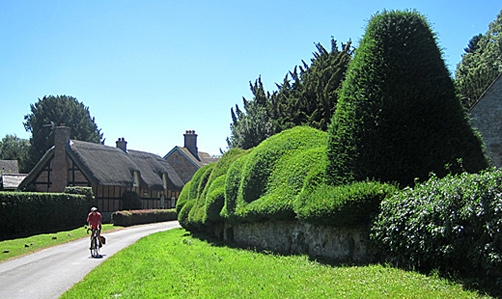
At Wigmore you might get glimpse of the ruined Wigmore Castle on your left as you cycle down the lane off Wigmore Rolls from the west. What's nice about this castle is that they've left alone and haven't 'cleaned it up'.
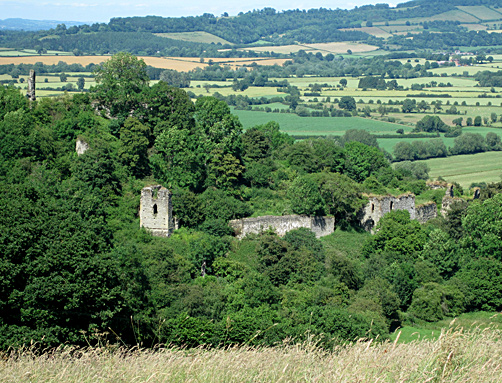
Cycling Route: see our Deerfold Ride from the village of Orelton (on the east side of the area) for ideas. Could also be done from Ludlow etc.
Dovecots
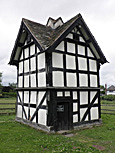 As
you cycle around Herefordshire, keep an eye out for dovecots. Only
the rich in their manor houses were allowed to build dovecots which
is why you tend to see them near big houses. Dovecots once housed
pigeons for a winter supply of meat and eggs for the big house. The
birds of course fed on the fields of the poor tenant farmers!
As
you cycle around Herefordshire, keep an eye out for dovecots. Only
the rich in their manor houses were allowed to build dovecots which
is why you tend to see them near big houses. Dovecots once housed
pigeons for a winter supply of meat and eggs for the big house. The
birds of course fed on the fields of the poor tenant farmers!
Good examples can be found at Brook House Farm, King's Pyon (photo below); opposite Luntley Court, south of Pembridge (photo left by Roger Cornfoot, open to the public); Eardisland (open, now a community shop, brick); Stocks Dovecot, Wellington (open?, octagonal, brick, 17C); and at Helens Manor, Much Marcle (octagonal, brick).

Photo: black & white dovecot in Brook House farmyard, King's Pyon.
The stone dovecot (photos below) at Garway is one of the best in the UK. Built in 1326 for the Knights Hospitallers, it replaced an even earlier dovecot built for the Knights Templar, who built the original round church next door. Inside are 666 L-shaped nests (666 is supposed to be the devil's number, so no wander that Daren Brown found this dovecot interesting). Located on private land in Church Farm's farmyard next to Garway Church so you need to get permission to visit (rats live in this dovecot so don't touch anything). Also take a detailed look inside and around the outside of the church - see how many religious symbols carved into the stonework you can find.
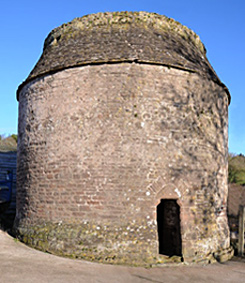
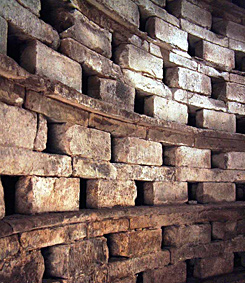
Photos: Garway dovecot outside, and detail of the 666 L-shape nests inside.
Apple & Pears
Herefordshire is famous for its apple and pear orchards. Every year there are two events which cyclists can join in. Both involve sampling the cider (made from apples) and perry (made from pears).

Photo: Leominster Morris dancing at Lynne Down Farm.
If you can't wait for one of these special events, there is a Cider Route you can follow anytime of the year.
Local cider-makers are worth checking out. Near Pembridge in north Herefordshire is Dunkertons Cider (long standing organic cider & perry - we've been drinking their perry since 1982 and very nice it is). At Much Marcle in south Herefordshire is Gregg's Pit and Lyne Down Farm. Near Abbey Dore in the Golden Valley in west Herefordshire is Gwatkins (at Morehampton Park Farm on B4347) - Gwatkins perry is our favourite.
The Woolhope Dome
A must place to cycle is the hidden world of the Woolhope Dome, to the SE of Hereford. Interesting geology gives the area its scenic scarps and dip-slopes formed by alternate beds of hard and soft rocks being laid down during the Silurian period 440 million years ago. The rocks were then folded up into an anticline (like a dome), which were subsequently unevenly eroded. The below cross-section shows this...
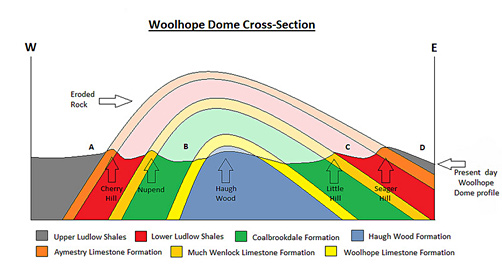
Image credit: Groundspeak
Personally, I've always described the Woolhope Dome thus: imagine an up-turned coffee cup on a saucer sitting on a slightly wrinkled check tablecloth. The cup represents the central hill (Haugh Wood on above cross-section). The saucer being the outer rim of the dome. The tablecloth being the surrounding fields on the Herefordshire plain. Climb up to the picnic site on the saucer rim at Cockshoot (above Prior's Frome; map ref 578 386) or Woolhope Cockshoot (above Putley; map ref 631 373) and with a bit of imagination you'll see what I mean - like being a little cycling ant sitting on a saucer looking out over a tablecloth! If you take the main lane west from the pub/church in Woolhope village (which I like to think is on the handle of the cup) you'll slip out of the saucer through a clink in the rim to the B4224 at Fownhope. Sometimes I see it more as an up-turned hospital bed pan!
Charming Churches
Herefordshire is brimfull of wonderful old churches, which are worth getting off your bike and visiting. Here are just a few...
Kilpeck Church
One of the most perfect little Norman churches in England is situated in the village of Kilpeck to the SW of Hereford. The church is famous for its saucy pagan carvings - in an exotic mix of Celtic, Scandinavian, Anglo-Saxon and French styles.
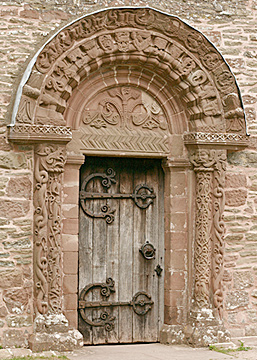
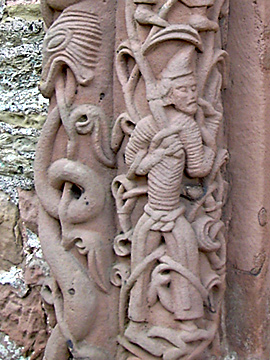
The doorway carvings contain a green men (photo below left); what is possibly very rare images of two Welsh soldiers; and a Basilisk (said to be born of a cock's egg, hatched by a toad or serpent and its glance lethal if it saw you first). Under the eaves all the way around the outside are some really exotic corbels (89 oringinally) depicting mythical creatures - a ram, a lion, hound and hare etc, and a really good example of a Sheila-na-gig (on the front wall, just before the curved bit; in photo below right its the left-hand corbel). Two more green men appear on the west wall.
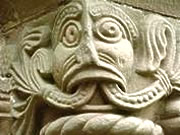
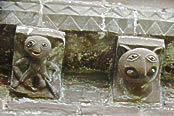
To the left of the churchyard are the ruins of the 11th century castle sitting on its mound. To the right of the churchyard you can still see the lumpy house-platforms of the deserted medieval village in the two fields either side of the road.
Location: Kilpeck village is 8 miles SW of Herefordshire; map ref: SO 445 305.
Brockampton Church
This 'Arts & Craft' church might look old, but in fact it was built in 1902 - "one of the most impressive and convincing churches of its date in any country", according to architectural historian Nikolaus Pevsner. The architect William Lethaby (a follower of William Morris and the Arts & Crafts movement) spent ages visiting the local churches before incorporating lots of their details into this church.
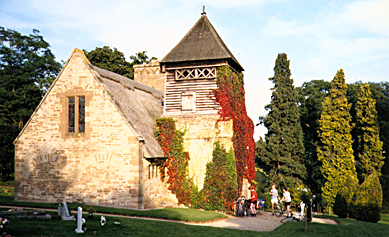
Photo: a group of cyclists visiting Brochampton church
Look closely and you'll notice that the roof is thatched on the outside but concrete on the inside - you can even see the impression of the timber planks used to hold up the roof while the concrete set. The west and north walls contain a blocked-up door and archways where there never were any. Either side of the alter are tapestries designed by Edward Burne-Jones and made in the William Morris workshops. Note the wild flowers carved on choir stalls and even more impressive are the flower-embroidered hymn book covers (a hand-written book at the back of the church explains some of the medical and culinery uses of these wild flowers. Wander around and you'll find amazing details everywhere [me, I love to touch the tactile sandstone pillars in the 2 small windows to the left of the altar].
Location: at Brockhampton village, between Hereford and Ross-on-Wye (not to be confused with Brockhampton near Bromyard).

Photo: valley by Brochampton church.
Much Marcle Church
The ancient yew tree opposite the church door can accommodate 7 cyclists (although it is rare to see all 7 in the photo!)...

Also, inside the church is a rare wooden carving of a knight returned from the crusades. What's so interesting about this carving is the detail of his tunic.
Abbey Dore Mon Amour
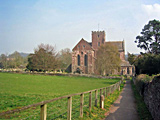 Dore
Abbey, in the Golden Valley village of Abbey Dore, is a wonderful
barn-like church. What you see today is but a small part of what was
once a great Cistercian monastery (constructed 1175-1280). After the
dissolution of the monasteries (1536), the nave and monastic
buildings were demolished for the stone, and the remaining building
became a cattle barn.
Dore
Abbey, in the Golden Valley village of Abbey Dore, is a wonderful
barn-like church. What you see today is but a small part of what was
once a great Cistercian monastery (constructed 1175-1280). After the
dissolution of the monasteries (1536), the nave and monastic
buildings were demolished for the stone, and the remaining building
became a cattle barn.

In 1630 it was turned into a Laudian church, and the medieval altar (which had been used cheese-making and salting meat) returned. Note the wall paintings, oak screen, musician's gallery, and the wonderful medieval stone carvings lying around on the floor. Stop and read the unfortunate wording of the inscription above the lych gate...

Location: Abbey Dore village is in the Golden Valley, 15 miles SW of Hereford, on the B4348, map reference 386 304. See Dore Abbey for details.
The Golden Valley
Lying between the Black Mountains and the River Wye at Hereford is the Golden Valley. The River Dore runs through the valley, the name possibly originating with the Norman invaders confusing the Welsh dwr (water) with the French d'or (of gold).
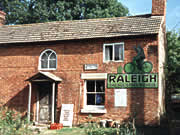 Villages
in the Golden Valley worth visiting are Dorstone; Vowchurch and
Turnastone (note old Raleigh Cycles sign on what used to be the
shop, photo left); Abbey Dore (see above); and Ewyas Harold.
Villages
in the Golden Valley worth visiting are Dorstone; Vowchurch and
Turnastone (note old Raleigh Cycles sign on what used to be the
shop, photo left); Abbey Dore (see above); and Ewyas Harold.
Ewyas Harold gets its name from Ewyas meaning 'sheep district'. Clodock, an early king of the small kingdom of Ewyas, was considered somewhat abnormal by his subjects. He was murdered by a hunting party who were apparently incensed to find him meditating!
Crumbling Castles
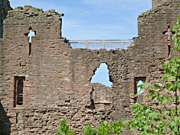 The
ruins of Goodrich Castle (between Ross-on-Wye and Symonds
Yat) are worth a visit, if only for the tearoom (don't have to pay
to enter cafe). The castle contains the only surviving Civil War
mortar, locally called 'Roaring Meg'.
The
ruins of Goodrich Castle (between Ross-on-Wye and Symonds
Yat) are worth a visit, if only for the tearoom (don't have to pay
to enter cafe). The castle contains the only surviving Civil War
mortar, locally called 'Roaring Meg'.
Not much remains of the castle at Longtown (map ref: SO 320 291) but the Keep which is worth climbing for the stunning views of the Olchon Valley and the looming Black Mountains.
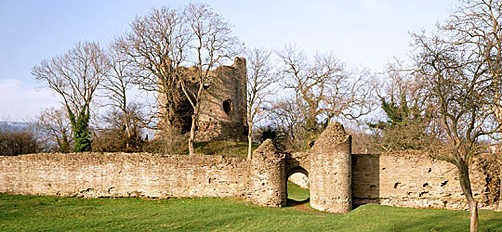
Photo credit: Longtown castle by English Heritage.
Cycling Maps
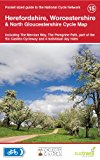 Herefordshire,
Worcestershire & North Gloucestershire Cycle Map - shows
on-road and traffic-free cycle paths, height contours, town centre
maps, recommended linking routes connecting the National Cycling
Network with quiet roads. Published by Sustrans. 1:110,000 scale.
About £6.
Herefordshire,
Worcestershire & North Gloucestershire Cycle Map - shows
on-road and traffic-free cycle paths, height contours, town centre
maps, recommended linking routes connecting the National Cycling
Network with quiet roads. Published by Sustrans. 1:110,000 scale.
About £6.
Or buy the ordinary Ordnance
Survey Landranger map Number 147 covering most of
Herefordshire from Amazon.co.uk; scale 1:50 000 (1.25 in to 1 mile),
about £9.
We take no responsibility and give no guarantees or warranties, implied or otherwise, for the content or accuracy of any linked sites above.




